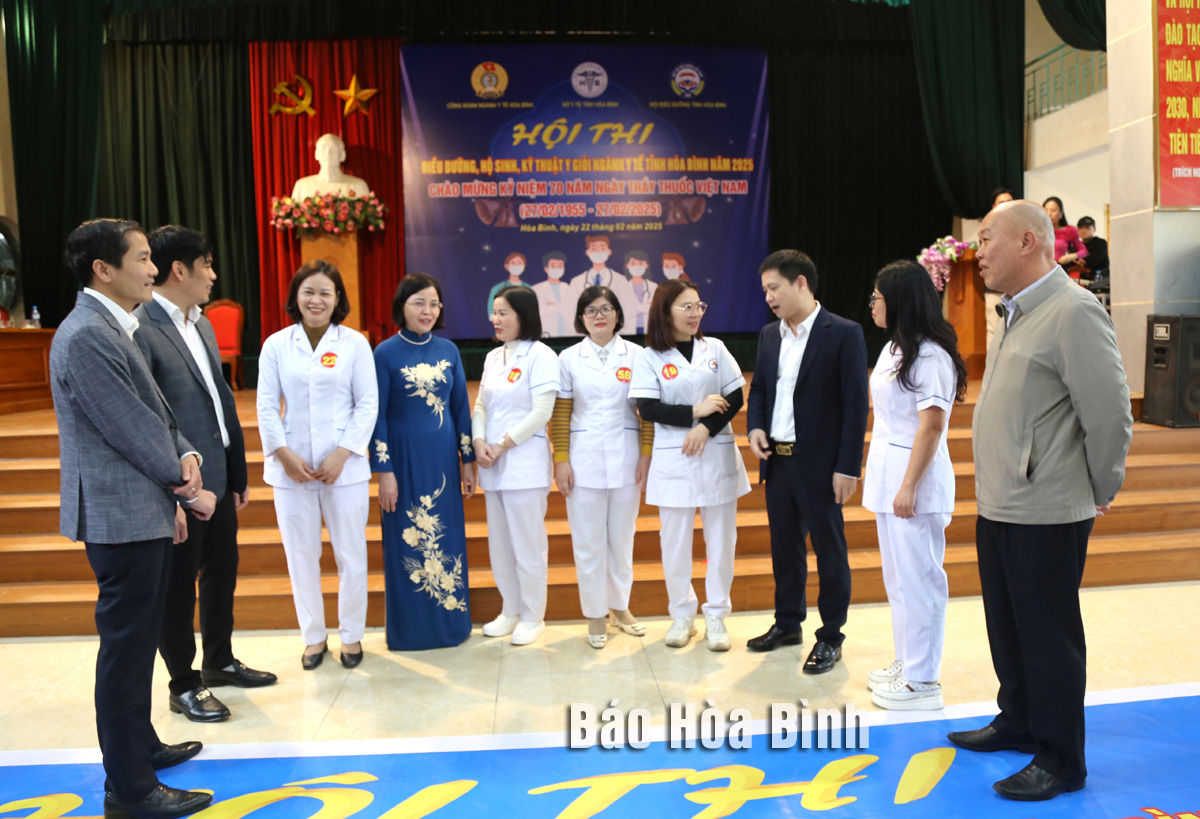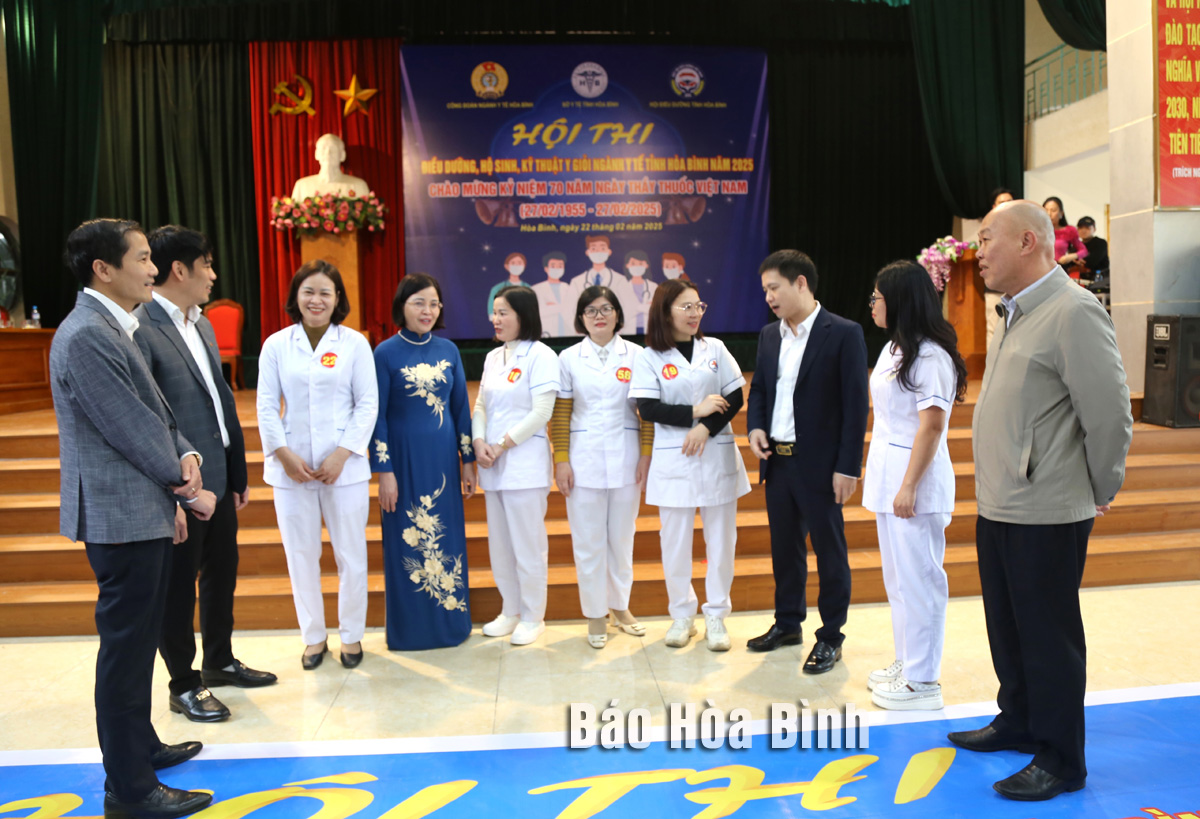
Over the past 70 years, the healthcare sector in Hoa Binh province has tirelessly overcome difficulties and followed President Ho Chi Minh’s teachings, Director of the provincial Department of Health Bui Thu Hang wrote in an article.

Leaders of the Department of Health discuss with prize-winning contestants at the Nursing, Midwifery, and Medical Technology Contest Celebrating the 70th anniversary of Vietnamese Doctor's Day (February 27, 1955 - February 27, 2025).
On February 27, 1955,
President Ho Chi Minh sent a letter to a conference of health officials. In his letter, he
emphasised three key points. Firstly, health workers must be honest and united,
as unity is our strength. Secondly, health workers take care of patients,
considering patients’ pain as their pain. Thirdly, Vietnam’s
healthcare system must be based on scientific principles, national identity,
and public service, integrating both traditional and modern medicine.
During the country’s resistance against the French colonialists, Hoa Binh was a
crucial area in the Northwest region, marked by the historic Hoa Binh campaign
and the legacy of the Tay Tien troops. In that historical context, the
healthcare system in Hoa Binh was formed from a military and civilian medical
team around 1947, later called Hoa Binh hospital. Resources were scarce, with
only a few stethoscopes, blood pressure monitors, and basic surgical tools. Its
medical workers were relocated a lot across localities in the province such as
Cao Phong, Kim Boi, and Muong Vo.
In early 1955, the Hoa Binh Department of Health was established. Both the
department and the hospital operated from makeshift shelters near the forest in
Mat village, Dan Chu commune. At that time, the hospital had only two nurses
trained during the French colonial period, with a physician leading the
department. Later, they moved to the old French hospital site in Dung street,
facing significant challenges in manpower and equipment. They got only two
bicycles for transport.
In 1956, both the hospital and department were relocated to newly-constructed
facilities in Doi Cham area which were still basic structures. The head of the
department also served as the hospital's director, and a primary healthcare
school was established there. By the end of 1956, Hoa Binh was recognised for
its sanitation and disease prevention initiatives, receiving a flag for
excellence.
In early 1960, a new provincial hospital was built, and in 1962, the provincial
administration constructed an office for the Department of Health and a medical
college, alongside specialised stations for disease prevention and control,
including malaria and tuberculosis.
During the US escalation in Vietnam, the Department of Health managed two
evacuations of the provincial hospital in 1968 and 1971 and established
emergency medical routes encompassing social, district, and provincial levels,
supported by mobile teams and ambulances. The Spring 1975 victory united the
country and opened opportunities for national and healthcare development.
After the province's merger, the Ha Son Binh Department of Health took
proactive measures to manage healthcare activities. However, infrastructure and
equipment remained inadequate. Since 1996, Hoa Binh’s healthcare sector
received support from international health projects, together with internal
resources to elevate the local healthcare system significantly.
Following the resolution No. 19-NQ/TW on October 25, 2017, Hoa Binh's
healthcare sector streamlined and merged units to enhance efficiency. The
Center for Disease Control was established by merging preventive health units,
bolstering disease surveillance and support for the primary healthcare system.
Over the years, Hoa Binh's healthcare workforce has grown from limited
resources to a large number of 3,631 health workers, including 1,573 with
university degrees, 254 with master's degrees or specialised training, 5 PhDs,
and 38 with advanced specialties, achieving a ratio of 9.8 doctors per 10,000
people. The sector has invested in modern equipment to improve diagnosis and
early detection of health issues.
The achievements of the healthcare sector over the past 70 years are a
testament to its efforts and commitment to overcoming challenges, aligning with
the mission of protecting and enhancing public health. The sector has received
numerous accolades from the Party, State, Ministry of Health, and provincial
authorities, including three Labour Orders, a third-class National Defence
Order, and other honours.
Looking ahead, the healthcare sector in Hoa Binh will continue to promote the
teachings of President Ho Chi Minh, enhance information technology
applications, and implement electronic health records and telemedicine systems.
The focus will also be on improving the quality of healthcare services,
training personnel, and encouraging the development of quality private
healthcare to meet the people's needs.
The emulation movement "Hoa Binh joining hands to build new-style rural areas” has been widely spreading, becoming a driving force that motivates the localities to renew rural landscapes and improve the material and spiritual lives of the residents. In this movement, the people play a central role-both as the main implementers and direct beneficiaries of its outcomes.
In response to the global digital revolution, Hoa Binh Newspaper is transforming itself into a modern and multi-platform media hub, blending cutting-edge technology with a restructured newsroom and a new generation of tech-savvy journalists.
Hoa Binh province’s Association of the Elderly recently held a conference to review the project on expanding the inter-generation self-help club model until 2025.
In a move to implement Resolution No. 57-NQ/TW, issued on December 22, 2024 by the Politburo, which targets breakthroughs in science-technology development, innovation, and digital transformation, the Hoa Binh provincial Department of Health has issued a plan to roll out the "Digital Literacy for All” campaign within the local health sector.
An Nghia Commune (Lạc Sơn District) is one of the communes that achieved the tha standard of the national new rural area in 2018. Entering a new development phase, the commune is now trying to meet the criteria for the advanced new rural development. With the strong political will and the public consensus, the commune is gradually overcoming the challenges to reach this goal, aiming for the sustainable development.



